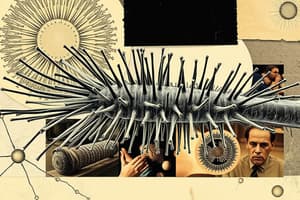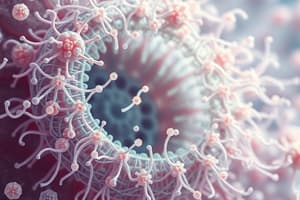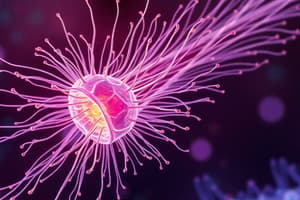Podcast
Questions and Answers
Lipid soluble substances can move through the lipid bilayer.
Lipid soluble substances can move through the lipid bilayer.
True (A)
Which of the following molecules is more lipid soluble than oxygen?
Which of the following molecules is more lipid soluble than oxygen?
The rate of diffusion of lipid soluble substances is directly proportional to their ______.
The rate of diffusion of lipid soluble substances is directly proportional to their ______.
lipid solubility
What type of protein channels allow water to pass through the cell membrane?
What type of protein channels allow water to pass through the cell membrane?
Signup and view all the answers
Which of the following statements is TRUE about aquaporins?
Which of the following statements is TRUE about aquaporins?
Signup and view all the answers
Match the following types of membrane channels with their regulation:
Match the following types of membrane channels with their regulation:
Signup and view all the answers
What is the main difference between pores and protein channels in the cell membrane?
What is the main difference between pores and protein channels in the cell membrane?
Signup and view all the answers
Charged ions are generally lipid soluble and can easily pass through the lipid bilayer.
Charged ions are generally lipid soluble and can easily pass through the lipid bilayer.
Signup and view all the answers
Molecular movement is constant and occurs only in one direction.
Molecular movement is constant and occurs only in one direction.
Signup and view all the answers
Which of the following factors directly influences the net diffusion rate across a semi-permeable membrane?
Which of the following factors directly influences the net diffusion rate across a semi-permeable membrane?
Signup and view all the answers
The ______ equation is used to calculate the balance between the electrical gradient and the concentration gradient.
The ______ equation is used to calculate the balance between the electrical gradient and the concentration gradient.
Signup and view all the answers
What is osmotic pressure?
What is osmotic pressure?
Signup and view all the answers
Match the following terms related to osmosis with their definitions:
Match the following terms related to osmosis with their definitions:
Signup and view all the answers
Which of the following is NOT a factor that affects the net diffusion rate across a semi-permeable membrane?
Which of the following is NOT a factor that affects the net diffusion rate across a semi-permeable membrane?
Signup and view all the answers
What is the normal osmolality of extracellular and intracellular fluids?
What is the normal osmolality of extracellular and intracellular fluids?
Signup and view all the answers
The osmolality of a solution is always equal to its osmotic pressure.
The osmolality of a solution is always equal to its osmotic pressure.
Signup and view all the answers
Secondary active transport utilizes the potential energy stored from primary active transport to move substances across the cell membrane.
Secondary active transport utilizes the potential energy stored from primary active transport to move substances across the cell membrane.
Signup and view all the answers
What is the primary mechanism responsible for the large concentration gradient of sodium ions across the cell membrane?
What is the primary mechanism responsible for the large concentration gradient of sodium ions across the cell membrane?
Signup and view all the answers
Explain how co-transport (symport) functions in secondary active transport.
Explain how co-transport (symport) functions in secondary active transport.
Signup and view all the answers
The ______ of the sodium ions outside the cell is constantly attempting to move into the interior due to the concentration gradient.
The ______ of the sodium ions outside the cell is constantly attempting to move into the interior due to the concentration gradient.
Signup and view all the answers
Which of the following is NOT an example of a cellular sheet where secondary active transport plays a role in substance transport?
Which of the following is NOT an example of a cellular sheet where secondary active transport plays a role in substance transport?
Signup and view all the answers
Match the following types of secondary active transport with their respective examples:
Match the following types of secondary active transport with their respective examples:
Signup and view all the answers
Describe how the active transport of sodium ions at the basal and lateral membranes of cellular sheets contributes to water transport across the entire sheet.
Describe how the active transport of sodium ions at the basal and lateral membranes of cellular sheets contributes to water transport across the entire sheet.
Signup and view all the answers
Counter-transport (antiport) is a more powerful mechanism than primary active transport in concentrating substances.
Counter-transport (antiport) is a more powerful mechanism than primary active transport in concentrating substances.
Signup and view all the answers
Which characteristics affect ion channel permeability?
Which characteristics affect ion channel permeability?
Signup and view all the answers
Potassium ions can pass through potassium channels 1000 times more readily than sodium ions.
Potassium ions can pass through potassium channels 1000 times more readily than sodium ions.
Signup and view all the answers
What is the role of the selectivity filter in ion channels?
What is the role of the selectivity filter in ion channels?
Signup and view all the answers
The process that allows substances to diffuse across a membrane with the help of carrier proteins is known as ________ diffusion.
The process that allows substances to diffuse across a membrane with the help of carrier proteins is known as ________ diffusion.
Signup and view all the answers
Match the following types of gating with their descriptions:
Match the following types of gating with their descriptions:
Signup and view all the answers
What is Vmax in relation to carrier proteins?
What is Vmax in relation to carrier proteins?
Signup and view all the answers
Chemical gating involves a conformational change caused solely by voltage changes.
Chemical gating involves a conformational change caused solely by voltage changes.
Signup and view all the answers
What type of ions does the acetylcholine receptor primarily allow to pass?
What type of ions does the acetylcholine receptor primarily allow to pass?
Signup and view all the answers
What is the primary function of the sodium-potassium pump?
What is the primary function of the sodium-potassium pump?
Signup and view all the answers
Osmolarity and osmolality refer to the same concept.
Osmolarity and osmolality refer to the same concept.
Signup and view all the answers
What is the concentration of potassium ions inside the cell in mEq/L?
What is the concentration of potassium ions inside the cell in mEq/L?
Signup and view all the answers
The process of moving ions against their concentration gradient requires __________ energy.
The process of moving ions against their concentration gradient requires __________ energy.
Signup and view all the answers
Match the type of transport with their definitions:
Match the type of transport with their definitions:
Signup and view all the answers
What type of transport is associated with the sodium-potassium pump?
What type of transport is associated with the sodium-potassium pump?
Signup and view all the answers
Sodium ions have a higher concentration inside the cell compared to outside.
Sodium ions have a higher concentration inside the cell compared to outside.
Signup and view all the answers
What happens to the sodium and potassium ions during the operation of the sodium-potassium pump?
What happens to the sodium and potassium ions during the operation of the sodium-potassium pump?
Signup and view all the answers
What is the primary function of the sodium-potassium pump in cells?
What is the primary function of the sodium-potassium pump in cells?
Signup and view all the answers
The sodium-potassium pump pumps 3 potassium ions into the cell for every 2 sodium ions pumped out.
The sodium-potassium pump pumps 3 potassium ions into the cell for every 2 sodium ions pumped out.
Signup and view all the answers
What creates the electrical potential across the cell membrane?
What creates the electrical potential across the cell membrane?
Signup and view all the answers
Calcium is maintained at extremely low intracellular concentrations, with _____ MEQ outside versus _____ MEQ inside.
Calcium is maintained at extremely low intracellular concentrations, with _____ MEQ outside versus _____ MEQ inside.
Signup and view all the answers
What primary role does the hydrogen ion transport serve in the stomach?
What primary role does the hydrogen ion transport serve in the stomach?
Signup and view all the answers
The sodium-potassium pump functions independently of ATP.
The sodium-potassium pump functions independently of ATP.
Signup and view all the answers
What are the two primary locations to which calcium is transported in muscle cells?
What are the two primary locations to which calcium is transported in muscle cells?
Signup and view all the answers
Match the ion with its primary active transport role:
Match the ion with its primary active transport role:
Signup and view all the answers
Study Notes
Motile Cilia
- Rapid whip-like strokes propel mucus and ova.
- Recovery movements are slower (10-20 per second).
- Inhibited by smoking.
- Found in respiratory airways (mucus movement) and fallopian tubes (ovum movement).
- Powered by dynein motor proteins and ATP.
Non-Motile Cilia
- Primary cilia act as sensory structures (e.g., kidney epithelial cells detecting fluid flow).
- Defects in primary cilia signaling can lead to disorders like polycystic kidney disease (pg. 28 Guyton).
Key Concepts
- Chemotaxis: Chemical signals direct cell movement.
- Autophagy: Cellular process to degrade and recycle damaged organelles or protein aggregates.
- ATP: Primary energy currency for cellular processes.
- Plasma membrane: Selectively permeable barrier maintaining cellular homeostasis.
Transport of Substances Through Cell Membranes
- Intracellular and extracellular fluid concentration differences are crucial for cell function.
- Extracellular fluid has high sodium and chloride, but low potassium.
- Intracellular fluid has high potassium and low sodium and chloride.
Studying That Suits You
Use AI to generate personalized quizzes and flashcards to suit your learning preferences.
Related Documents
Description
Explore the fascinating world of cilia with this quiz on motile and non-motile types. Learn about their roles in transport, signaling, and implications for health. Test your understanding of essential concepts related to cellular processes and membrane transport.




